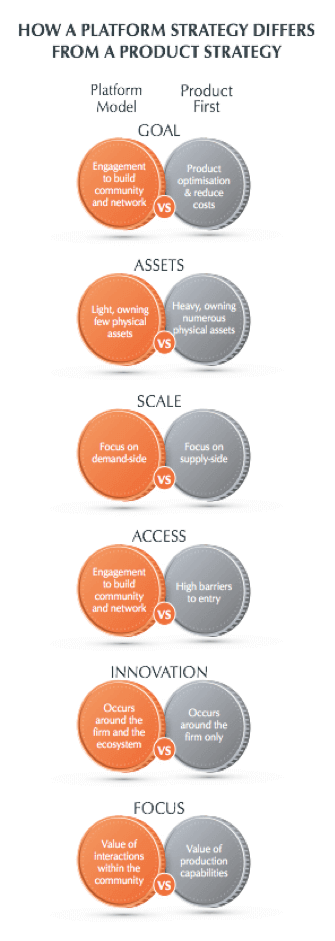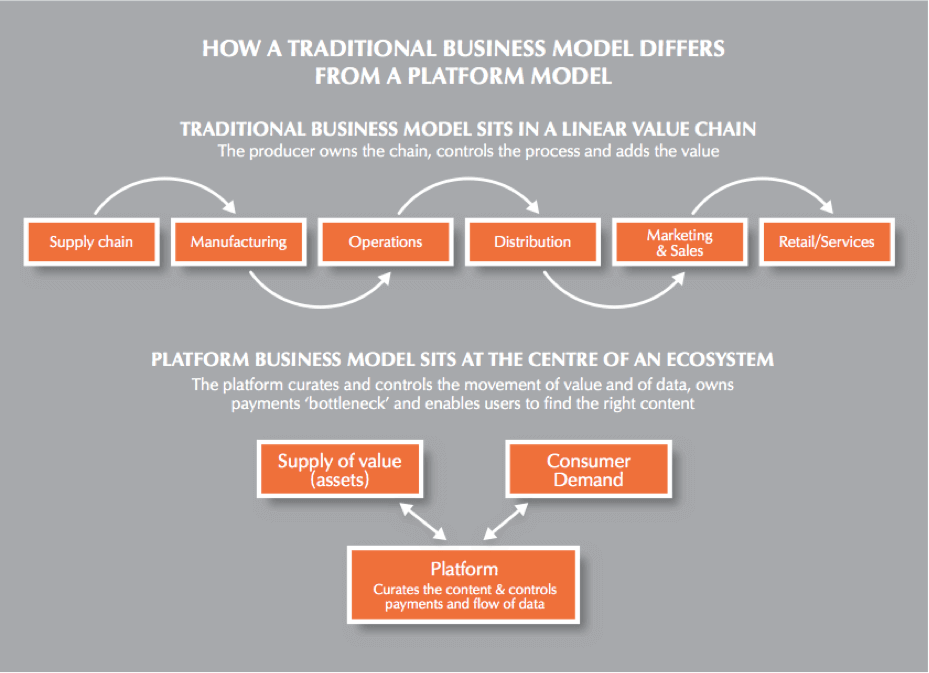
In his seminal work “What is Strategy,” Michael Porter identifies a key pillar of successful strategy as having high barriers to entry. However, building such barriers is becoming harder with the digital technologies that define today’s business landscape.
For this reason, the conventional business model that sits within a linear value chain delivering standalone products and services is on the verge of breaking. Significant obstacles to growth and competitive challenges may lie ahead for product-first or product-only companies as their customers increasingly turn elsewhere.
Where are these customers going? To competitors that put them at the heart of everything they do. What strategy do these successful companies follow? They adopt a platform-strategy and subsequently a platform-enabled business model.
Platforms have the ability to attend to and change with customer needs while putting you in control at the same time.
What is a Platform?
Broadly-speaking, a technology platform has three defining features:
- A base layer of technology that allows users to create value and exchange value in the form of products and services.
- Software that allows third-party developers to contribute to its development by adding technology stacks and connecting through APIs.
- A governance model that explains the type of behaviour that is permissible on that platform.

The most obvious examples of platform-only companies include Amazon, Uber, Airbnb, LinkedIn and Facebook. Apple combines both platform (iTunes) and product (iPhone). Microsoft is another established technology company that made the shift to platform.
There are a number of previously product-first or even industrial firms that have transitioned from product only to product plus platform. Nike, for example, fitted instruments in shoes, connected mobile devices and then hosted analytics in the cloud to develop an ecosystem and social community enabling users to log runs, interact with each other, join teams and engage in challenges. By building a platform, Nike added significant value on top of their core products.
The Competitive Edge of Platforms
In 2007, Samsung, Sony Ericsson, Nokia, LG, Blackberry and Motorola controlled 90 per cent of mobile phone profits. Ten years later, the iPhone alone controls 92 per cent of global profits. By failing to make the shift to platform, these firms remained product-first companies and had their market shares wiped out. There are 3 principal reasons why platforms beat products:
- By shifting from a linear value-chain to a platform model, companies place themselves at the top of the food-chain, rather than being a mere component of it.
- Being at the centre of this new ecosystem is an investment in the oil of the 21st century: data – and specifically, the flow of data.
Transforming from product to platform means that competitors can become complimentary if their products are compatible with your platform.

How to make the shift to Platform
Building a platform business is difficult, but undergoing the transformation might be of critical importance to your company because of the aforementioned threats to traditional product-first business models. It is imperative to begin this journey by focusing on customer needs by following this six-step framework:
-
Customer needs
Ensure you understand exactly what value your customer wants and how your platform can enable them to exchange that value.
-
Network effects
Know how you will attract sufficient users and ensure your decisions are guided by the right acquisition strategy based on the unique value proposition of your platform.
-
Monetisation
Know which side of the platform you’ll monetise from, and how that revenue stream will be generated.
-
Technology
Ensure the right investments are made remembering that customers expect great UX design.
-
Behaviour
Develop a clear governance model and ensure you have good data protection & encryption.
-
Products and services
Continuously build additional features on the platform, and adjust to consumer demand by allowing developers to build their own products using your platform infrastructure.
Creating a platform will also necessitate a change in your business model (either in its entirety or by building a separate function with a new business model). The following four steps can serve as a framework for companies to support the shift to platform by enabling the creation of a new business model within the company:
-
Understand what changes need to occur in your workforce (sudden skills gap and filling key positions, e.g. engineers, developers and systems engineers).
-
Company mindset needs to change to manage the global vs local nature of the business – this will affect your marketing strategy and execution.
-
There will be a substantial need for technological investment: are you prepared to become a technology company? What is your current technology environment, how have you planned to absorb the changes, and what are the specific requirements you still need to address to prepare?
-
The re-allocation of resources: how will you create liquidity? How will you offset the ongoing, substantial investment and potential initial lack of revenue?
Conclusion
Beginning the transition to a platform-based or platform-enabled business model requires leadership committed to building the right environment. This includes developing the right platform architecture, investing in front-end capabilities to allow for the optimisation of the platform’s value and implementing great design so that users will enjoy a streamlined experience.
Platforms succeed because it is far easier to add product functionalities to a platform, and then subsequently create network effects, than vice-versa. By building a platform, strategy must move away from resource control and focus on the value of the exchange. In the process, companies not only put their customers at the heart of everything they do, they position themselves at the centre of a new ecosystem – they are no longer just a component in a linear value chain. This also allows them to collect more data about their customer’s behaviour, which in turn allows them to better serve and anticipate their needs.
Finally, a platform model opens up the possibility for firms to monetise and profit from the physical assets of other firms without owning those assets by extracting and facilitating the value, from those assets to consumers. The asset-light platform model enables a company to scale in a way that is not possible for asset-heavy product-centric firms.









